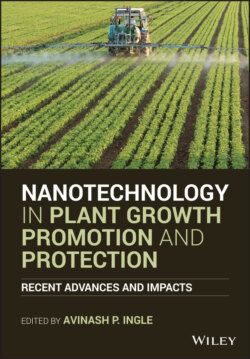Читать книгу Nanotechnology in Plant Growth Promotion and Protection - Группа авторов - Страница 55
3.3.2.2 Effects of Zn NPs Used in Agar Media and Hydroponic Application
ОглавлениеZn NPs can promote early plant growth through agar media or hydroponic applications. Ramesh et al. (2014) found a substantial increase in chlorophyll and protein content in wheat through agar application of ZnO NPs (20–50 nm) between 250 and 2000 mg/L with minimal or no toxic effects. Mung bean and chickpea are grown in agar media at 20 and 1 mg/L, showed an increase of root length, root biomass, shoot length, and shoot biomass by 42 and 53%, 41 and 37%, 98 and 6%, and 76 and 27%, respectively. However, the application of ZnO NPs at 2000 mg/L caused a significant reduction in the growth rates of mung bean and chickpea seedlings (Mahajan et al. 2011). Studies indicated that coatings on Zn NPs can enhance the efficiency of Zn supplement. Research conducted in agar gel media by Moghaddasi et al. (2017) reported a better Zn supply through humic acid‐coating nanoparticle (ZnO) at 1 mg/L with a substantial increase in root and shoot biomass in cucumber.
Several recent studies reported the beneficial effect of Zn NP when added to the hydroponic system. Venkatachalam et al. (2017) reported the application of Zn NPs (25–200 mg/L) in combination with 100 mM phosphate in a hydroponic system increased cotton (Gossypium hirsutum L.) biomass by 131% over control. Tirani et al. (2019) reported a similar effect of ZnO NPs (25 nm) in the growth promotion of Nicotiana tabacum when supplied to the hydroponic system together with nutrient solution. The results obtained revealed that these NPs positively affected the growth of N. tabacum, that is, root length, shoot length, and plant biomass. However, the phytotoxicity of Zn NPs in the hydroponic system has also been reported. Ghodake et al. (2011) reported that ZnO NPs (5, 10, and 20 μg/mL) can inhibit onion bulbs (Allium cepa) root elongation in the hydroponic system because of severe accumulation of ZnO NPs in both the cellular and the chromosomal modules. Further investigations are needed to understand the interactions between Zn NPs with plants in a hydroponic system to optimize the beneficial effect of Zn NPs on plants.
